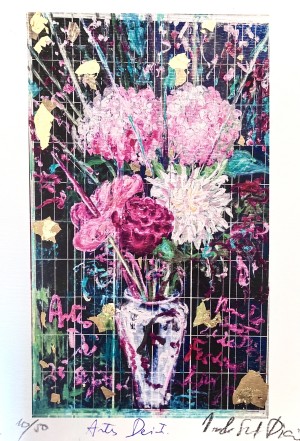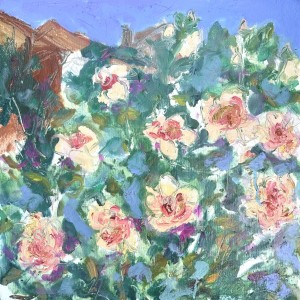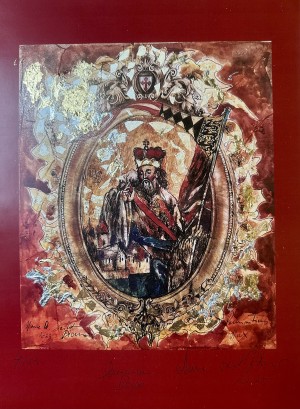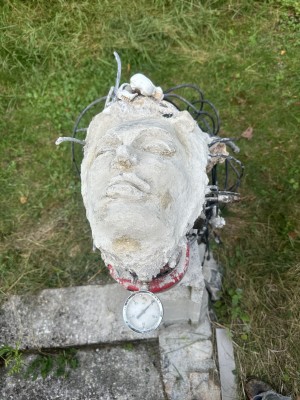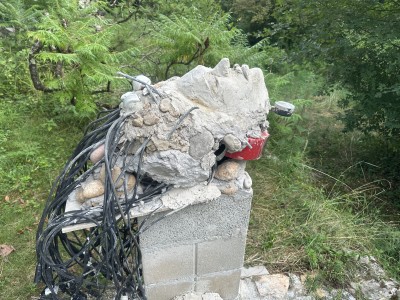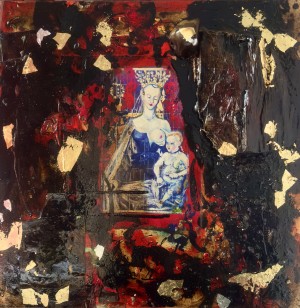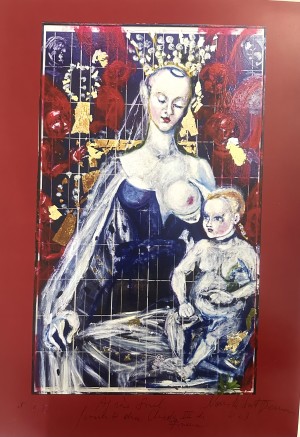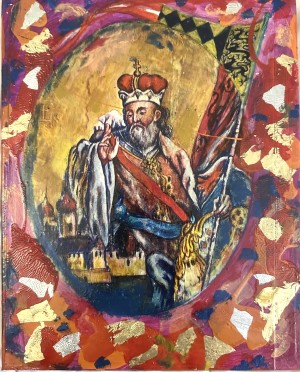Painting created in occasion of ARTES DEI event and exhibition at Festival Ljubljana, after flowers offered at opening event.
Exhibition was exposed at Plecnik’s Lapidarium, opening held at Devil’s court and Knight’s Hall. Performance and exhibition by artist Norma de Saint Picman 24. 9. - 23. 10. 2020, 24. September - 23. October 2020, Atrium and Knights' Hall, Križanke, https://ljubljanafestival.si/en/event/artes-dei/
The installation in the Entrance Hall of Ljubljana’s Križanke completes the cycle as the third in a series of exhibitions in September, which included a presentation with performance and ceramic sculpture at “Fragmented Identities”, part of the BORDERS Festival presented by the ITSLIQUID platform in Palazzo Albrizzi-Capello in Venice (September 4, 2020), and a major solo exhibition of paintings on solar panels, ceramic sculptures, painted ceramics and glass plates, accompanied by the opening performance “Luce dell eterno”, (5–17 September 2020), as part of the parallel exhibition of the 4th edition of the international Venice Glass Week, and the 77th Venice Film Festival at the Lido di Venezia, in the restored medieval Glass Cathedral – Santa Chiara on the island of Murano. On September 5, the opening day of the Venice Glass Week, an exceptional exhibition featuring 60 women artists working in glass, titled “Unbreakable – Women in Glass”, opened in the nearby Berengo Studio. I had the honour of meeting Adriano Berengo and painting his portrait on a solar panel behind the hanging exhibits by Joana Vasconcelos and Ai Wei Wei, while in the Cathedral a portrait of one of its owners, Giuseppe Belluardo was shown.
The exhibition of painted solar panels in the Križanke Entrance Hall and the performance continue the cycle of works from Santa Chiara – with a five-meter painting of the sunset, inspired by a photograph of Maurizio Eltri “Lido di Venezia – Isolo d’Oro”, placed along the entire outer wall of the Entrance Hall into the window niches of the stone wall. Placed at the exterior entrance is my first painted solar panel – the diptych “La reine Soleil”, first exhibited at Contemporary Venice in Palazzo Ca’ Zanardi in December 2019.
The exhibition highlights connections among painting, architecture, sculpture and performance. I sincerely thank Suncontract and Bisol for supporting these projects.
The three panels in the inner part of the Entrance Hall with the lapidary refer to the exterior sculptures – the medieval sculptural diptych of “Progress” and “Learning” in the arched niches of the Plečnik-renovated courtyard with sgraffito decoration – while the painting of the Madonna and Child is based on the stone bas-relief on the truncated corner of the wall between the City Museum and the Križanke Church. “I have elected and dedicated this place, so that my name remains there forever…”
In the early 1950s, the city’s Commission for Culture and Education took the initiative to restore the nationalised monastery, which had been mostly abandoned. Plečnik came up with the idea of designing a lapidary, and thus rearranging the monastery into what would become known as Plečnik’s Križanke.
My mother, the architect, painter and graphic artist Alenka Kham Pičman, who was Plečnik’s student at the time (her graduation project, titled “Ribja Brv”, envisioned a footbridge over the Ljubljanica that would represent a continuation of the iconic Three Bridges, with stone balusters and sculptures of Urška and the Merman and musicians), recalls how architecture students were also involved in the design of the Križanke lapidary as part of a seminary; a part of her narrative is included in the accompanying video presented at Križanke’s Knight’s Hall.
Throughout the composition, Plečnik incorporated architectural remains (portals, pillars, statues) of the old demolished Ljubljana houses at Ajdovščina, and decorated the outer wall along Zoisova Street with a plaque in memory of Andrej Smole and a sculpture of Anton Aškerc. In front of the entrance to the former Prelature, Plečnik designed a lapidary with a colonnade housing the remains of the former Gothic church. The small adjacent atrium was rearranged into the Devil’s Courtyard, which was connected to the rest of the complex with specially designed sconces. In the inner part of the atrium, the exhibition continues with “Luna’s Boy” and three panels from the spring cycle “Paradise Gardens/Les jardins d’Eden” – “Red Bush”, “A Bride’s Dress” and “Hydrangeas”, all executed in rich coats of oil paint.
On the left and right sides, on the atrium lawn, we stroll amid a group of Priestesses – meditating polyester sculptures in various colours from a 1997 project, presented in Congress Square as part of the European Month of Culture.
Artes Dei – which combines dreams, consecration and the divine, is united in a universal language of ancient cultures, countless religions and beliefs, presenting a single pure recognition of eternal peace and love.
Norma de Saint Picman

